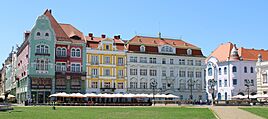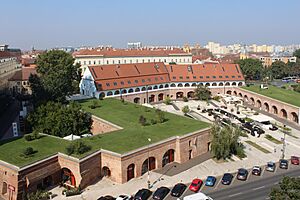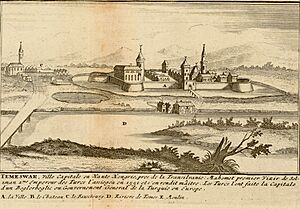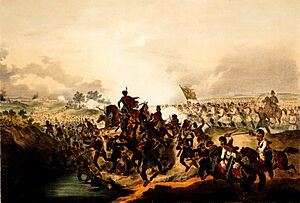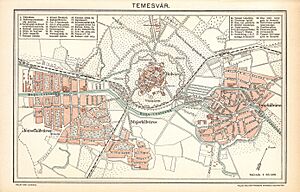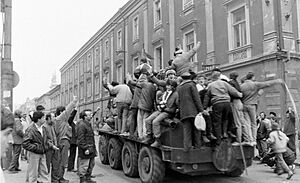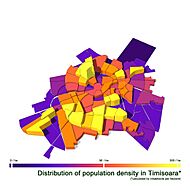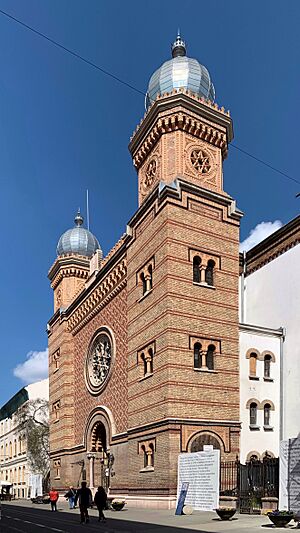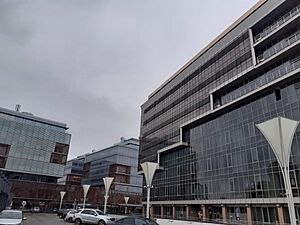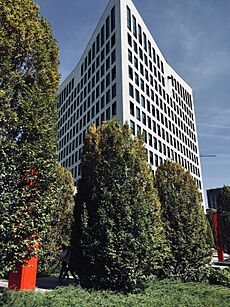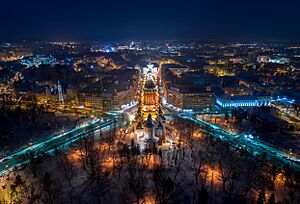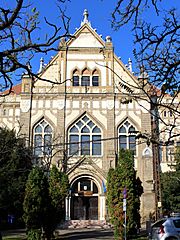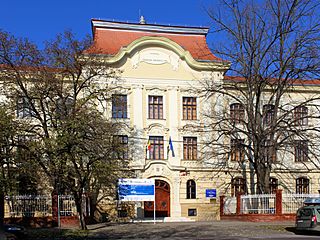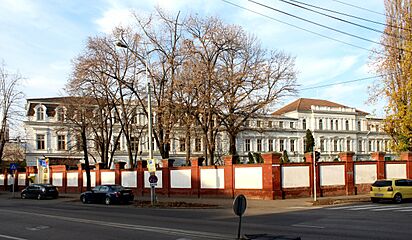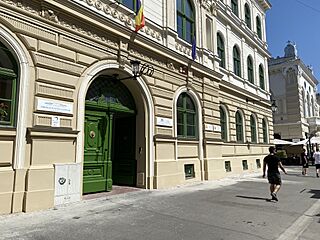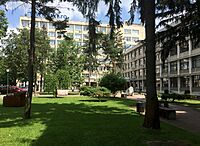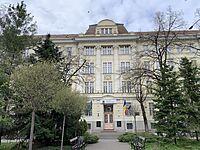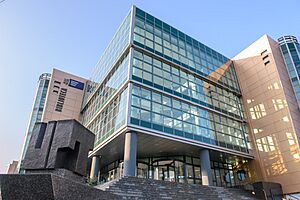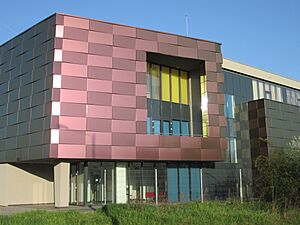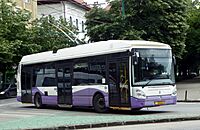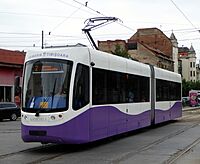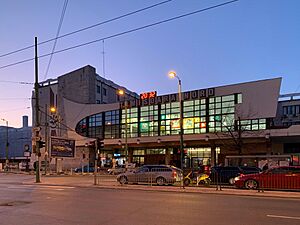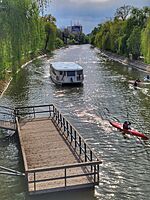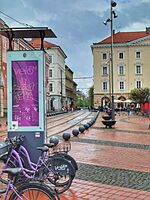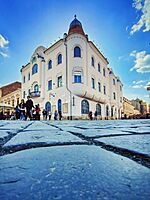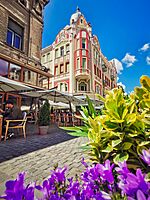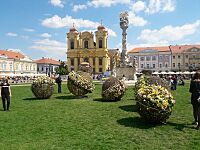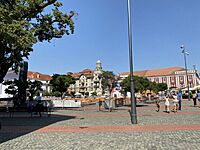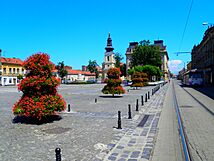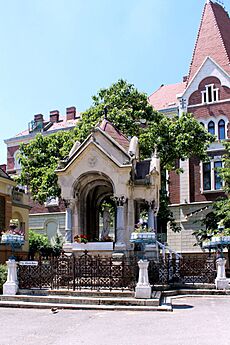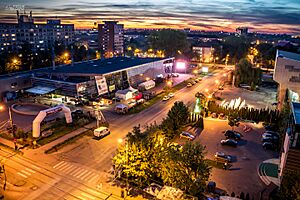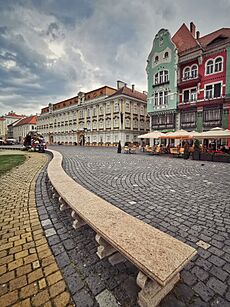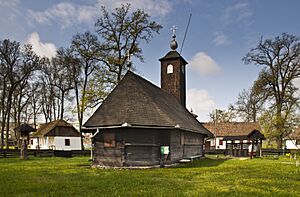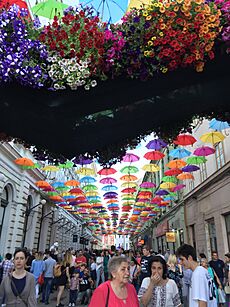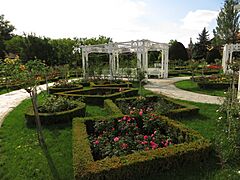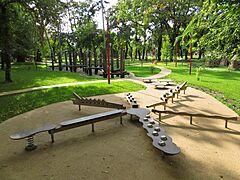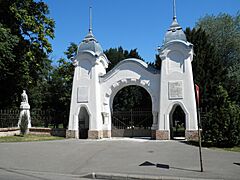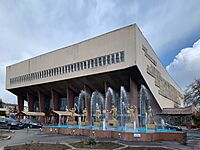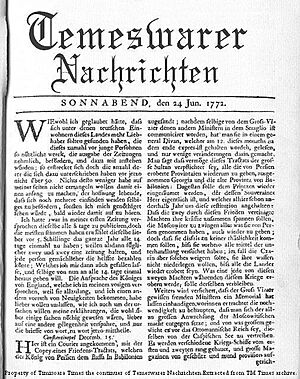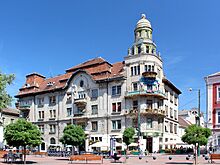Timișoara facts for kids
Quick facts for kids
Timișoara
|
|||
|---|---|---|---|
|
Aerial view overlooking Roses Park and the Bega
Victory Square facing the Metropolitan Cathedral
Capitoline Wolf
Romanian National Opera
Liberty Square
Union Square
|
|||
|
|||
| Nickname(s):
Little Vienna, City of Roses, City of Parks, Garden City
|
|||
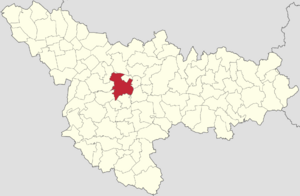
Location in Timiș County
|
|||
|
OpenStreetMap
|
|||
| Country | Romania | ||
| County | Timiș | ||
| Status | County seat | ||
| First official record | 1212 (as castrum regium Themes) | ||
| Area | |||
| • City | 130.03 km2 (50.20 sq mi) | ||
| • Metro | 1,080.31 km2 (417.11 sq mi) | ||
| Elevation | 90 m (300 ft) | ||
| Population
(2021 census)
|
|||
| • City | 250,849 | ||
| • Rank | 5th | ||
| • Density | 1,929.16/km2 (4,996.51/sq mi) | ||
| • Metro | 430,071 | ||
| Demonyms | timișorean, timișoreancă (ro) temesvári (hu) temeswarer, temeswarin (de) |
||
| Time zone | UTC+2 (EET) | ||
| • Summer (DST) | UTC+3 (EEST) | ||
| Postal code |
300xyz1
|
||
| Tel. code | +40 x562 | ||
| Car plates | TM | ||
| Climate | Cfb | ||
| 1x, y and z are digits that indicate the street, part of the street or even the building of the address 2x is a digit indicating the operator: 2 for the former national operator, Romtelecom, and 3 for other ground telephone networks |
|||
Timișoara is a major city in Western Romania. It's the capital of Timiș County and a key center for business, culture, and social life. The city is located on the Bega River. Many people consider Timișoara the unofficial capital of the historic Banat region.
From 1848 to 1860, it was even the capital of the Serbian Vojvodina. In 2021, Timișoara had about 250,849 residents, making it the fifth largest city in Romania. Its wider metropolitan area is home to around 400,000 people.
Timișoara is a city with many cultures, where 21 different ethnic groups and 18 religious groups live together. Historically, the largest groups were German Swabians, Jews, and Hungarians. These groups still make up about 6% of the population today.
The Austrians took control of Timișoara from the Ottoman Turks in 1716. Over the next centuries, the city grew around its strong defenses. By the late 1800s, these old walls were no longer needed due to new military technology. They were taken down and replaced with new streets and neighborhoods.
Timișoara was the first city in the Habsburg monarchy to have street lighting in 1760. It was also the first European city to use electric street lamps in 1884. The city opened the first public library in the Habsburg monarchy and built a hospital 24 years before Vienna. It also published the first German newspaper in Southeast Europe, called Temeswarer Nachrichten. In December 1989, Timișoara was where the Romanian Revolution began.
Today, Timișoara is an important place for education in Romania. About 40,000 students attend its six universities. It's also a hub for medical tourism, especially for dental care and cosmetic surgery. Important medical breakthroughs have happened here, like the first laser heart surgery and the first stem cell transplant.
As a technology center, Timișoara has one of the strongest IT sectors in Romania. In 2013, it even had the fastest internet download speed in the world!
Timișoara is often called "Little Vienna" or the "City of Roses." It's famous for its many historical buildings and 36 parks. Nearby, you can find spa resorts like Buziaș and Băile Călacea, known since Roman times for their healing waters. Timișoara is part of the Art Nouveau European Route and a member of Eurocities.
The city has a lively cultural scene with three state theaters, an opera house, a philharmonic orchestra, and many other cultural places. In 2016, Timișoara was the first Romanian Youth Capital. In 2023, it was a European Capital of Culture, sharing the title with Veszprém in Hungary and Elefsina in Greece.
Contents
- What's in a Name?
- A Look at Timișoara's Past
- Where is Timișoara?
- Who Lives in Timișoara?
- Timișoara's Economy
- Learning in Timișoara
- Health Care in Timișoara
- Getting Around Timișoara
- Timișoara's Buildings and Style
- Culture and Arts
- Parks and Green Spaces
- Sports in Timișoara
- News and Media
- Famous People from Timișoara
- Timișoara's International Friends
- See Also
What's in a Name?
The Hungarian name for the city, Temesvár, was first written down in 1315. It means "castle" (vár) on the Timiș River (Temes). The name Timiș comes from an old word meaning "swamp." The Romanian name (Timișoara) and German name (Temeschburg) both came from the Hungarian form. The Austrian rulers also used Temeschwar or Temeswar, which are still common today. The city's name comes from a smaller river, Timișul Mic, which was later changed to Bega or Beghei.
Banat Bulgarian: Timišvár
Banat Swabian: Temeschwar
Bosnian: Temišvar
Croatian: Temišvar
Czech: Temešvár or Temešov
Dutch: Temeswaar
Greek: Τιμισοάρα, romanized: Timisoára
Latin: Timisvaria
Ottoman Turkish: تمشوار, romanized: Temešvār
Polish: Temeszwar
Russian: Темешвар, romanized: Temeshvar
Serbian: Темишвар, romanized: Temišvar
Slovak: Temešvár
Slovene: Temišvar
Turkish: Temeşvar or Tamışvar
Ukrainian: Темешвар, romanized: Temeshvar
Yiddish: טעמעשוואַר, romanized: Temeshvar
A Look at Timișoara's Past
![]() Kingdom of Hungary (1212–1526)
Kingdom of Hungary (1212–1526)
![]() Eastern Hungarian Kingdom (1526–1551)
Eastern Hungarian Kingdom (1526–1551)
![]() Kingdom of Hungary (1551–1552)
Kingdom of Hungary (1551–1552)
![]() Ottoman Empire (1552–1716)
Ottoman Empire (1552–1716)
![]() Habsburg Monarchy (1718–1779)
Habsburg Monarchy (1718–1779)
![]() Kingdom of Hungary (1779–1849)
Kingdom of Hungary (1779–1849)
![]() Austrian Empire (1849–1867)
Austrian Empire (1849–1867)
![]() Austria-Hungary (1867–1918) (de jure Hungary until 1920)
Austria-Hungary (1867–1918) (de jure Hungary until 1920)
![]() Banat Republic (1918) (de facto)
Banat Republic (1918) (de facto)
![]() Kingdom of Serbia (1918–1919) (de facto)
Kingdom of Serbia (1918–1919) (de facto)
![]() Kingdom of Romania (1920–1947) (de facto from 1919)
Kingdom of Romania (1920–1947) (de facto from 1919)
![]() Romanian People's Republic (1947–1965)
Romanian People's Republic (1947–1965)
![]() Socialist Republic of Romania (1965–1989)
Socialist Republic of Romania (1965–1989)
![]() Romania (1989–present)
Romania (1989–present)
How it All Started
The area where Timișoara is located was a very fertile place. People lived here as early as 4000 BC. They were farmers, hunters, and craftspeople.
Some historians believe that Timișoara might be the site of an ancient Dacian settlement called Zurobara.
Timișoara in the Middle Ages
Timișoara was first officially mentioned in 1212 as a royal castle. The city was destroyed by the Tatars in the 1200s. But it was rebuilt and grew a lot under King Charles I of Hungary. He ordered stone walls and a royal palace to be built in 1307. The King even moved his royal home from Buda to Timișoara for a few years.
By the mid-1300s, Timișoara was a key city in the fight against the Muslim Ottoman Turks. In 1394, the Turks passed through the area on their way to Wallachia. Later, Timișoara was a gathering point for Christian armies before the battle of Nicopolis.
An important event was the peasant uprising led by György Dózsa in 1514. He tried to change the path of the Bega River to enter the city more easily, but he was defeated.
Ottoman Rule (1552–1716)
After the fall of Belgrade in 1521, the Kingdom of Hungary was divided. Banat became a battleground between the Habsburg Kingdom of Hungary and the Ottomans. On April 22, 1552, a large Ottoman army conquered the city. Timișoara then became a regional capital for the Ottoman Empire.
Timișoara stayed under Ottoman rule for 164 years. It was directly controlled by the Sultan and had a special status. During this time, it was home to a large Islamic community.
Habsburg Rule (1716–1860)
After a big victory in 1716, the Austrian army, led by Prince Eugene of Savoy, decided to conquer Timișoara. The city was heavily bombed during a 48-day siege. Many buildings were destroyed. After the Treaty of Passarowitz in 1718, the Banat of Temeswar became a province of the Habsburg monarchy.
The Austrian authorities invited many German Catholics to settle here. These settlers became known as Banat Swabians. In Timișoara, they mostly settled in the Fabric area, where they greatly developed crafts. The city's main purpose during this time was to be a military fortress. The old defenses were rebuilt to be much stronger and larger. Between 1728 and 1732, the Bega River was made into a navigable canal.
In 1779, Timișoara became part of the Hungarian Kingdom again. In 1781, Emperor Joseph II declared Timișoara a "free royal city." This meant it could govern itself and manage its own money. The city was under siege in 1848 for 107 days. The Hungarians tried but failed to capture the fortress. This was the last major battle of the Hungarian Revolution of 1848.
19th and 20th Centuries
In 1860, Timișoara became part of the Kingdom of Hungary again. As part of Austria-Hungary, the city grew quickly in terms of economy and population. Banks invested a lot in local industries. By the early 1900s, there were many factories, including breweries, an iron foundry, and a chocolate factory. During this time, horse-drawn trams, telephones, and street lighting were introduced, and roads were paved.
In 1892, Emperor Franz Joseph I decided that Timișoara no longer needed to be a fortress. The old fortifications began to be torn down in 1899. The city then focused more on business, especially trade and banking.
After World War I

After World War I, the Banat region was divided. Timișoara came under Romanian control after a Serbian occupation. The city was officially given from Hungary to Romania by the Treaty of Trianon in 1920. In the same year, King Ferdinand I made Timișoara a University Center. The years between the two world wars saw continued economic and cultural growth.
During World War II, Timișoara was damaged by bombs from both Allied and Axis forces. On August 23, 1944, Romania joined the Allies. German and Hungarian troops tried to take the city, but they failed.
After the war, Romania became a communist country. Timișoara became very industrial, with many new factories. The city's population tripled between 1948 and 1992.
In December 1989, Timișoara was the starting point of the Romanian Revolution. On December 20, it was declared the first city in Romania to be free from communism.
Where is Timișoara?
Timișoara is located in the northern hemisphere, about halfway between the north pole and the equator. It's in the eastern hemisphere, using Central European Time.
The city sits at an altitude of 90 meters on the edge of the Banat Plain. It's near where the Timiș and Bega rivers meet. This area used to be very swampy and often flooded. Timișoara grew in one of the few places where these swamps could be crossed. The swamps also protected the fortress for a long time.
In the 1700s, the rivers were drained and controlled. The Bega Canal was built starting in 1728. Because of these projects, the city is no longer directly on the Timiș River, but on the Bega Canal. This made the land much better. The city is only 0.5 to 5 meters above the water level, which means very tall buildings are difficult to build. The rich, dark soil and high water level make this a very good area for farming.
The land in Timișoara is mostly flat. The Bega River is the main feature that breaks up the smooth surface.
Earthquakes in Timișoara
Timișoara is in an area with some earthquake activity. However, most earthquakes here are not very strong, rarely going above magnitude 6 on the Richter scale. There are two active fault lines that cross the western part of the city. Earthquakes in this region are usually shallow, occurring between 5 and 30 kilometers deep.
Plants and Animals
In the past, there were huge oak forests around Timișoara. They were cut down for wood to build the fortress and houses, and to create farmland. Today, most of the area is forest steppe, except for some forests with Turkey oak and Hungarian oak. Along the rivers, you can find trees like willows, poplars, and alders.
Inside the city, there's the Green Forest (Pădurea Verde), which is about 724 hectares. This forest was planted by people, with the first plans made in 1860. About 20 kilometers southeast of Timișoara is the Bazoș Dendrological Park. This is a protected forest reserve with 800 different kinds of trees and shrubs.
Timișoara's wildlife includes a few small mammals like hedgehogs and moles. Birds are more common, including pheasants. In the city's parks, you can also find tree frogs. The main fish species in the rivers is the carp, along with breams and pikes.
Rivers and Lakes
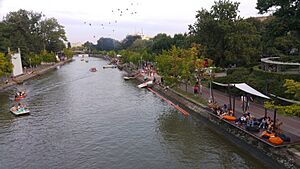
The main river is the Bega River. It starts in the Poiana Ruscă Mountains and is a canalized river. From Timișoara to where it flows out, it was made suitable for boats. The Bega Canal was built between 1728 and 1760. It was designed for large barges carrying goods.
Inside the city, only two old branches of the Bega remain: Bega Moartă (Dead Bega) and Bega Veche (Old Bega).
Timișoara also has several lakes. Some are natural, formed from old river bends or low areas. Others were created by people, like those near Fratelia and Freidorf.
Timișoara's Weather
Timișoara has a humid continental climate, which means it has warm summers and cold winters. It also gets some influences from the Mediterranean Sea.
The average yearly temperature between 1991 and 2020 was 11.8°C. July is usually the warmest month, averaging 22.7°C. January is the coolest, averaging 1.0°C. The lowest temperature ever recorded was -35.3°C in January 1963. The highest was 42°C in August 2017.
Timișoara gets more rain than cities in the Wallachian Plain. The average yearly rainfall is 604.4 mm, spread over 87 days. June is usually the wettest month, and February is the driest.
| Climate data for Timișoara (1991–2020, extremes 1901-2020) | |||||||||||||
|---|---|---|---|---|---|---|---|---|---|---|---|---|---|
| Month | Jan | Feb | Mar | Apr | May | Jun | Jul | Aug | Sep | Oct | Nov | Dec | Year |
| Record high °C (°F) | 17.4 (63.3) |
20.5 (68.9) |
28.2 (82.8) |
32.0 (89.6) |
34.5 (94.1) |
39.0 (102.2) |
39.7 (103.5) |
41.0 (105.8) |
39.7 (103.5) |
33.8 (92.8) |
27.1 (80.8) |
20.2 (68.4) |
41.0 (105.8) |
| Mean daily maximum °C (°F) | 3.9 (39.0) |
6.8 (44.2) |
12.6 (54.7) |
18.8 (65.8) |
23.7 (74.7) |
27.4 (81.3) |
29.7 (85.5) |
29.9 (85.8) |
24.1 (75.4) |
18.3 (64.9) |
11.5 (52.7) |
4.9 (40.8) |
17.6 (63.7) |
| Daily mean °C (°F) | 1.0 (33.8) |
1.9 (35.4) |
6.5 (43.7) |
12.2 (54.0) |
17.2 (63.0) |
20.9 (69.6) |
22.7 (72.9) |
22.5 (72.5) |
17.0 (62.6) |
11.5 (52.7) |
6.4 (43.5) |
1.5 (34.7) |
11.8 (53.2) |
| Mean daily minimum °C (°F) | −3.0 (26.6) |
−1.9 (28.6) |
1.6 (34.9) |
6.4 (43.5) |
11.1 (52.0) |
14.8 (58.6) |
16.3 (61.3) |
16.3 (61.3) |
12.7 (54.9) |
7.1 (44.8) |
2.8 (37.0) |
−1.3 (29.7) |
6.9 (44.4) |
| Record low °C (°F) | −35.3 (−31.5) |
−29.2 (−20.6) |
−20.0 (−4.0) |
−5.2 (22.6) |
−5.0 (23.0) |
2.2 (36.0) |
5.9 (42.6) |
5.0 (41.0) |
−1.9 (28.6) |
−6.8 (19.8) |
−15.4 (4.3) |
−24.8 (−12.6) |
−35.3 (−31.5) |
| Average precipitation mm (inches) | 35.7 (1.41) |
34.2 (1.35) |
34.6 (1.36) |
48.3 (1.90) |
60.5 (2.38) |
80.8 (3.18) |
59.5 (2.34) |
57.7 (2.27) |
51.2 (2.02) |
50.4 (1.98) |
45.2 (1.78) |
46.3 (1.82) |
604.4 (23.79) |
| Average precipitation days (≥ 1.0 mm) | 6.8 | 7.0 | 6.8 | 7.5 | 8.6 | 8.6 | 7.4 | 5.7 | 7.1 | 6.4 | 7.0 | 8.5 | 87.4 |
| Average relative humidity (%) | 90 | 86 | 79 | 73 | 73 | 74 | 73 | 75 | 76 | 81 | 85 | 89 | 80 |
| Mean monthly sunshine hours | 74 | 107 | 165 | 208 | 243 | 263 | 282 | 279 | 194 | 162 | 96 | 61 | 2,134 |
| Source 1: NOAA Deutscher Wetterdienst | |||||||||||||
| Source 2: National Institute of Statistics (extremes, 1901–2000) | |||||||||||||
| Climate data for Timișoara (1961-1990) | |||||||||||||
|---|---|---|---|---|---|---|---|---|---|---|---|---|---|
| Month | Jan | Feb | Mar | Apr | May | Jun | Jul | Aug | Sep | Oct | Nov | Dec | Year |
| Mean daily maximum °C (°F) | 2.3 (36.1) |
5.6 (42.1) |
11.9 (53.4) |
17.6 (63.7) |
22.8 (73.0) |
25.7 (78.3) |
27.8 (82.0) |
27.6 (81.7) |
24.0 (75.2) |
18.1 (64.6) |
10.3 (50.5) |
4.2 (39.6) |
16.5 (61.7) |
| Daily mean °C (°F) | −1.6 (29.1) |
1.2 (34.2) |
5.8 (42.4) |
11.2 (52.2) |
16.3 (61.3) |
19.4 (66.9) |
21.1 (70.0) |
20.4 (68.7) |
16.5 (61.7) |
11.0 (51.8) |
5.6 (42.1) |
0.8 (33.4) |
10.6 (51.2) |
| Mean daily minimum °C (°F) | −4.8 (23.4) |
−2.3 (27.9) |
1.2 (34.2) |
5.8 (42.4) |
10.1 (50.2) |
13.4 (56.1) |
14.6 (58.3) |
14.3 (57.7) |
11.2 (52.2) |
6.2 (43.2) |
2.1 (35.8) |
−1.7 (28.9) |
5.8 (42.5) |
| Average precipitation mm (inches) | 40 (1.6) |
36 (1.4) |
37 (1.5) |
48 (1.9) |
65 (2.6) |
76 (3.0) |
64 (2.5) |
50 (2.0) |
40 (1.6) |
39 (1.5) |
48 (1.9) |
50 (2.0) |
593 (23.5) |
| Average snowfall cm (inches) | 9.8 (3.9) |
9.3 (3.7) |
4.4 (1.7) |
0.0 (0.0) |
0.0 (0.0) |
0.0 (0.0) |
0.0 (0.0) |
0.0 (0.0) |
0.0 (0.0) |
0.0 (0.0) |
3.7 (1.5) |
7.2 (2.8) |
34.4 (13.6) |
| Average precipitation days (≥ 1.0 mm) | 7 | 7 | 7 | 8 | 9 | 10 | 7 | 6 | 6 | 5 | 8 | 9 | 89 |
| Average dew point °C (°F) | −3.3 (26.1) |
−1.5 (29.3) |
1.5 (34.7) |
5.2 (41.4) |
10.3 (50.5) |
13.4 (56.1) |
14.3 (57.7) |
14.2 (57.6) |
11.5 (52.7) |
7.1 (44.8) |
2.8 (37.0) |
−0.6 (30.9) |
6.2 (43.2) |
| Mean monthly sunshine hours | 72.1 | 92.2 | 155.4 | 186.4 | 242.4 | 262.3 | 300.6 | 280.2 | 217.5 | 177.3 | 86.4 | 56.9 | 2,129.7 |
| Source: NOAA NCEI | |||||||||||||
Who Lives in Timișoara?
Ethnic composition of Timișoara (2021) Romanians (91.39%) Hungarians (4.3%) Serbs (1.44%) Germans (1.13%) Others (1.74%)
Religious composition of Timișoara (2021) Romanian Orthodox (79.55%) Catholics (8.06%) Pentecostals (2.53%) Baptists (1.67%) Reformed (1.32%) Serbian Orthodox (1.1%) Others (2.52%) Irreligious, atheists and agnostics (3.25%)
| Historical population | ||
|---|---|---|
| Year | Pop. | ±% |
| 1787 | 9,479 | — |
| 1847 | 18,103 | +91.0% |
| 1869 | 32,725 | +80.8% |
| 1880 | 33,694 | +3.0% |
| 1890 | 39,884 | +18.4% |
| 1900 | 53,033 | +33.0% |
| 1910 | 72,555 | +36.8% |
| 1920 | 82,689 | +14.0% |
| 1930 | 91,580 | +10.8% |
| 1941 | 110,840 | +21.0% |
| 1948 | 111,987 | +1.0% |
| 1956 | 142,257 | +27.0% |
| 1966 | 174,243 | +22.5% |
| 1977 | 269,353 | +54.6% |
| 1992 | 334,115 | +24.0% |
| 2002 | 317,660 | −4.9% |
| 2011 | 319,279 | +0.5% |
| 2021 | 250,849 | −21.4% |
| Source: Census data, Encyclopædia Britannica Eleventh Edition | ||
Timișoara is a very important city in western Romania. It has the second largest functional urban area in Romania, after Bucharest.
In 2021, the official population of Timișoara was 250,849. This was a decrease from 2011. However, local officials believe the actual number is higher, over 309,000, because many students and workers live in the city but aren't counted in the official census.
Timișoara attracts many people from other parts of Romania. About 46.2% of the people living in Timișoara today moved there from somewhere else.
Different Cultures in Timișoara
Timișoara has always been a city with many different cultures. In 1910, the largest group was Germans, followed by Hungarians and Romanians. Today, about 85% of the people are Romanians. There are also many other groups, including Asians, Italians, and Muslims.
Timișoara has the highest percentage of Germans in Romania compared to other cities. The number of German and Hungarian people has decreased over time. This is because some have moved away, and many have married people from other ethnic groups. Timișoara also has a large Serbian community.
In 2018, over 7,000 foreigners officially lived in Timișoara. The real number is likely higher, as many don't apply for permanent residence.
| Census | Total | Romanians | Hungarians | Germans | Jews | Romani | Ukrainians | Serbs | Croats | Czechs | Slovaks | Bulgarians |
|---|---|---|---|---|---|---|---|---|---|---|---|---|
| 1880 | 38,702 | 5,037 (13.02%) |
7,529 (19.45%) |
20,518 (53.02%) |
N/A | N/A | 28 (0.07%) |
2,415 (6.24%) |
N/A | N/A | 405 (1.05%) |
N/A |
| 1890 | 45,948 | 5,594 (12.17%) |
11,100 (24.16%) |
24,973 (54.35%) |
N/A | N/A | 27 (0.06%) |
2,363 (5.14%) |
52 (0.11%) |
N/A | 332 (0.72%) |
N/A |
| 1900 | 60,551 | 6,312 (10.42%) |
19,162 (31.65%) |
30,892 (51.02%) |
N/A | N/A | 13 (0.02%) |
2,730 (4.51%) |
130 (0.21%) |
N/A | 288 (0.48%) |
N/A |
| 1910 | 74,003 | 7,593 (10.26%) |
28,645 (38.71%) |
32,963 (44.54%) |
N/A | N/A | 4 (0.01%) |
3,490 (4.72%) |
149 (0.20%) |
N/A | 341 (0.46%) |
N/A |
| 1920 | 86,850 | 16,047 (18.48%) |
27,189 (31.31%) |
32,097 (36.96%) |
8,307 (9.56%) |
N/A | N/A | N/A | N/A | N/A | N/A | N/A |
| 1930 | 102,390 | 25,207 (24.62%) |
31,773 (31.03%) |
33,162 (32.39%) |
7,264 (7.09%) |
379 (0.37%) |
56 (0.05%) |
2,237 (2.18%) |
N/A | N/A | 652 (0.64%) |
279 (0.27%) |
| 1941 | 125,052 | 46,466 (37.16%) |
24,891 (19.9%) |
37,611 (30.08%) |
N/A | N/A | N/A | N/A | N/A | N/A | N/A | N/A |
| 1956 | 142,257 | 75,855 (53.32%) |
29,968 (21.07%) |
24,326 (17.1%) |
6,700 (4.71%) |
122 (0.09%) |
56 (0.04%) |
3,065 (2.15%) |
N/A | 649 (0.46%) |
575 (0.4%) |
280 (0.2%) |
| 1966 | 174,243 | 109,100 (62.61%) |
31,016 (17.8%) |
25,058 (14.38%) |
2,590 (1.49%) |
120 (0.07%) |
71 (0.04%) |
4,188 (2.4%) |
N/A | 516 (0.3%) |
490 (0.28%) |
475 (0.27%) |
| 1977 | 269,353 | 191,742 (71.19%) |
36,724 (13.63%) |
28,429 (10.55%) |
1,629 (0.6%) |
1,109 (0.41%) |
299 (0.09%) |
6,776 (2.52%) |
124 (0.05%) |
481 (0.18%) |
404 (0.15%) |
942 (0.35%) |
| 1992 | 334,115 | 274,511 (82.16%) |
31,785 (9.51%) |
13,206 (3.95%) |
549 (0.16%) |
2,668 (0.8%) |
756 (0.23%) |
7,748 (2.32%) |
93 (0.03%) |
227 (0.07%) |
675 (0.20%) |
1,314 (0.39%) |
| 2002 | 317,660 | 271,677 (85.52%) |
24,287 (7.65%) |
7,157 (2.25%) |
367 (0.12%) |
3,062 (0.96%) |
762 (0.24%) |
6,311 (1.99%) |
142 (0.04%) |
171 (0.05%) |
570 (0.18%) |
1,218 (0.38%) |
| 2011 | 319,279 | 259,754 (81.36%) |
15,564 (4.87%) |
4,193 (1.31%) |
176 (0.06%) |
2,145 (0.67%) |
556 (0.17%) |
4,843 (1.52%) |
101 (0.03%) |
124 (0.04%) |
385 (0.12%) |
859 (0.27%) |
| 2021 | 250,849 | 176,615 (70.41%) |
8,313 (3.31%) |
2,189 (0.87%) |
111 (0.04%) |
745 (0.3%) |
400 (0.16%) |
2,776 (1.11%) |
77 (0.03%) |
90 (0.04%) |
275 (0.11%) |
643 (0.26%) |
| Note: censuses in italics are based on mother tongue rather than ethnicity. | ||||||||||||
Religions in Timișoara
Timișoara has a mix of religions. In 1910, most people were Roman Catholics. By 2011, 75% identified as Romanian Orthodox.
There are 80 churches in Timișoara. 41 belong to the Orthodox Church, and eight to the Roman Catholic Church. There are also three synagogues built before World War I. Today, only two of them still hold religious services.
Timișoara is an important center for both the Orthodox and Roman Catholic churches in the region.
Timișoara's Economy
Timișoara is one of Romania's most active economic centers. Because it's close to the western border, it has attracted many foreign investments. Most of these investments come from countries in the EU, especially Italy, Germany, and France. The services sector, like banking and IT, has grown a lot and now makes up half of the city's income.
After communism ended in 1989, the private business sector grew steadily. In the early 2000s, Timișoara experienced a big economic boom. This was due to more foreign investment, especially in high-tech areas. In 2016, Forbes magazine named Timișoara the most dynamic city and the best city for business in Romania. The city also has one of the lowest unemployment rates in the country.
Factories and Industries
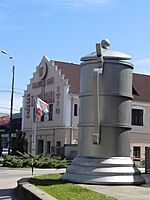
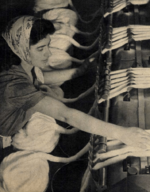
Timișoara has eight industrial zones. These areas have factories that make everything from electronics and chemicals to car parts and textiles.
The automotive parts industry has grown a lot. Many famous companies like Continental and Dräxlmaier have factories here. The electronics industry is also very successful, with big companies like Flex and Bosch. The chemical industry is traditional in Timișoara, with companies like Procter & Gamble.
Besides these large companies, many smaller businesses operate in traditional fields like textiles and footwear. Foreign investors are interested in these areas because of lower production costs.
Office Buildings and Business Parks
The number of modern office buildings has increased a lot in the last ten years. Timișoara has a very low vacancy rate for these offices, meaning most are rented out.
City Business Center is a major office park in the city center. It's home to international companies like Accenture and IBM. Vox Technology Park is known as one of the greenest office projects in Romania. Nokia's campus is located in Bega Business Park. Another big project, United Business Center, will include Romania's tallest office building.
IT and Tech Sector
Timișoara is a leading city in Romania for the IT industry. Well-known companies like Google, Microsoft, IBM, and Nokia have offices here. They support new tech companies and small businesses.
Before Cluj-Napoca grew rapidly, Timișoara had the most IT professionals after Bucharest. In 2014, there were 7,000 IT employees in the city. Timișoara also has Incuboxx, the largest IT business incubator in Romania.
In 2019, Timișoara was ranked 394th in the Innovation Cities Index. This list shows the world's most innovation-friendly cities.
Real Estate and Housing
The housing market in Timișoara has been booming. In 2017, about 4,000 new homes were built. Most of these were tall apartment buildings. Timiș County has one of the largest real estate markets in Romania, after Bucharest.
The price of an apartment in Timișoara reached 1,300 euros per square meter in 2020. This is the third highest among big Romanian cities.
Shopping and Retail
Bega Shopping Center is the only shopping center in the heart of Timișoara. It was the first in the city.
Iulius Mall opened in 2005. It has been combined with a larger project called Iulius Town. This new area has the largest shopping space in Romania, with over 450 stores. It gets more than 20 million visitors each year.
The second big mall, Shopping City, opened in 2016. It has 110 stores and a large Cinema City movie theater.
Many supermarkets and DIY stores have also opened in Timișoara.
Tourism in Timișoara
Timișoara is the main tourist destination in its region. In the first half of 2017, it attracted over 50,000 foreign tourists. This made it the third most visited region in Romania.
In 2013, Timișoara had 107 places to stay, including hotels, hostels, and guesthouses.
Learning in Timișoara
Schools and High Schools
Timișoara has many schools for different age groups. There are 70 kindergartens, 47 primary schools, and 36 high schools. There are also special schools for students with disabilities.
A unique thing about Timișoara's schools is that they teach in many languages. You can find schools teaching in Hungarian, German, English, French, and Serbian.
Several high schools in Timișoara are ranked among the top 100 in Romania.
Universities and Higher Education
Higher education in Timișoara started over 100 years ago with the Polytechnic University in 1920. Today, Timișoara is the most important university center in western Romania. About 40,000 students attend its four public and two private universities.
The Polytechnic University is one of the largest technical universities in Central and Eastern Europe. The West University is the largest in the city by student numbers. Timișoara also has a medical university, the Victor Babeș University of Medicine and Pharmacy. The King Michael I University of Life Sciences focuses on life sciences and veterinary medicine.
Student campuses offer about 13,000 places to live. The Complexul Studențesc area is especially known for its lively nightlife with many pubs and nightclubs.
Timișoara has several important libraries, including:
- The Library of the Victor Babeș University of Medicine and Pharmacy.
- The Central Library of the Polytechnic University.
- The Eugen Todoran Central University Library, with over one million books.
- The Sorin Titel County Library.
Scientific Discoveries
Several research institutes are located in Timișoara. These include institutes for electrochemistry, welding, chemistry, and an Astronomical Observatory.
The West University has many research centers. These cover topics like environmental research, criminal sciences, and computer sciences.
The first computer built in Romania, called MECIPT, was created at the Polytechnic Institute of Timișoara in 1961.
Many famous scientists and inventors have come from or worked in the Timișoara area. These include Traian Vuia, who invented the first tractor monoplane, and Stefan Hell, who won the 2014 Nobel Prize in Chemistry.
Health Care in Timișoara
Timișoara is a research center for medicine and public health. It has branches of the Academy of Medical Sciences and other medical societies.
There are eight hospitals in Timișoara, seven public and one private. The largest is the Pius Brînzeu County Emergency Clinical Hospital. There are also many dental offices, family medicine offices, and pharmacies.
Getting Around Timișoara
Timișoara is an important center for roads and railways. It connects the city to Bucharest and other major cities in Romania. It also links Romania to Hungary and Serbia, and further into Western Europe. The Bega Canal also provides access to a European waterway.
Roads and Driving
Timișoara has over 1,278 streets, totaling almost 750 kilometers. The city's road network spreads out from the center like spokes on a wheel.
A bypass road is in the northern part of the city. The A1 motorway passes northeast of the city and connects to the M43 motorway in Hungary.
Timișoara is connected to the European and national road networks by several important roads. Car ownership has grown a lot since 1990. Timișoara also has many charging stations for electric cars.
Public Transportation
Timișoara's public transport system includes nine tram lines, eight trolleybus lines, and 31 bus lines. It covers all important areas of the city and connects to some nearby towns. About 45% of public transport is by tram. In 2019, Timișoara started public school transport.
The city has many taxi services and car rental companies. You can also use carpooling apps like Uber and Bolt.
For longer bus trips, there are several bus stations. Daily bus trips are available to destinations across Europe.
Trains and Railways
Timișoara has the oldest and densest railway network in Romania. It's the most important train hub in western Romania. The main passenger station is Timișoara North. It was built in 1897 and is currently being renovated. It's one of the busiest stations in Romania.
Timișoara is also an important center for rail freight transport, with many factories sending and receiving goods by train.
Air Travel
Traian Vuia International Airport is located 12 kilometers from the city. It's the fourth-busiest airport in Romania. It's also the most important airport in the DKMT Euroregion. The airport is currently expanding with new terminals.
Other Ways to Get Around
The Bega Canal is the first navigable canal built in Romania. It connects Timișoara with the Serbian town of Titel. In 2018, work began to repair the canal so boats can travel between Timișoara and Serbia again.
Since 2018, Timișoara has public water transport using vaporetto-like boats on the Bega Canal.
Timișoara has the best cycling system in Romania. Cyclists have over 100 kilometers of bike lanes. This includes a path along the Bega Canal that connects to the European cycling network. Timișoara was the first city in Romania to have a public bike-sharing system, called VeloTM, which started in 2015.
In 2019, Timișoara also introduced public transport with electric scooters.
Timișoara's Buildings and Style
Timișoara has the largest collection of historic buildings in Romania, with about 14,500. Most of these buildings are from the time of the Austrian Empire. The mix of styles, like Baroque, Neoclassical, and Art Nouveau, earned Timișoara the nickname "Little Vienna."
The oldest building in Timișoara is Huniade Castle, which now houses the Museum of Banat. It was rebuilt after being damaged in 1849.
Timișoara has a city structure with several distinct areas. The historic center (Cetate neighborhood) is in the middle. Only a few parts of the old city wall remain today, like the Theresia Bastion.
Historic Neighborhoods
Cetate: The City Center
The Cetate neighborhood is the political, administrative, and cultural heart of Timișoara. It has two main parts. The first is the "inner city" from the 1700s and 1800s, with the oldest buildings. The second part was built after 1900, when the old city walls were torn down. Buildings here followed the popular fin de siècle style, similar to Art Nouveau.
Timișoara's historic center has three unique public squares:
- Union Square (Piața Unirii) is the oldest. It's built in Baroque style and is home to the Roman Catholic Dome. The Baroque Palace, which looks like a palace in Vienna, is also here.
- Victory Square (Piața Victoriei), also called Opera Square, is the central square. It's a pedestrian area between the Metropolitan Cathedral and the Palace of Culture, which houses the National Theater and Opera. The Opera building has a Renaissance style, while the Metropolitan Cathedral has a unique neo-Byzantine style.
- Liberty Square (Piața Libertății) connects Union Square and Victory Square. It has buildings with military history, like the Military Casino. In this square, the first horse-drawn tram started running in 1869.
Fabric: The Industrial Heart
The Fabric neighborhood got its name from the many factories and workshops that were built here. At its center is Trajan Square (Piața Traian), which looks like a smaller version of Union Square. Most buildings here were built in the late 1800s in different Art Nouveau styles. The Millennium Church in Romans' Square is a large historic building with neo-Gothic and neo-Romanesque elements.
Iosefin: The Railway District

The Iosefin neighborhood used to be more rural, with isolated houses. This changed in 1857 when Timișoara was connected to the railway system. The city's first railway station was built here. Most buildings in Iosefin were built after 1868, many around 1900. They show styles like eclectic historicist and Art Nouveau. Important buildings include the Water Palace and the Water Tower.
Elisabetin: The Garden Suburb
Like Iosefin, Elisabetin also had a rural feel for a long time. It developed greatly after 1892 when the military fortress was dismantled. Only two 18th-century buildings remain here. Many houses have been replaced by taller buildings.
Mary Square (Piața Maria) is an important historical square in Elisabetin. It has the neo-Romanesque monument of St. Mary. Legend says György Dózsa, a peasant uprising leader, was martyred here. Other squares include Nicolae Bălcescu Square with its tall Catholic Church, and Pleven Square with its Art Nouveau buildings.
Buildings from 1919 to 1947
Between the two world wars, new buildings were often in the Neo-Romanian style, or modernist and cubist styles. More Romanian architects designed buildings during this time. Famous architect Duiliu Marcu designed the new facade of the Theater and buildings for the Polytechnic Institute.
Buildings from 1947 to 1989
During the communist period, Timișoara's architecture followed the Soviet style. Architects had little freedom. However, unlike some other cities, Timișoara authorities did not demolish entire historic neighborhoods. Instead, they built new blocks of flats in empty spaces.
The communist era saw a big increase in Timișoara's population. Many workers moved to the city, leading to the construction of large apartment blocks. By the late 1980s, most people lived in these new suburbs.
Buildings from 1990 to Today
After 1989, Romanian architecture reconnected with European styles. Many new projects were built. The city's economy changed, and many old factories were torn down. In their place, new housing complexes and shopping malls were built.
The 2010s brought a new period of urban development. Projects like Iulius Town and ISHO created new "mini-cities" within Timișoara, adding more facilities and expanding the urban area.
Culture and Arts

Art Galleries
Timișoara has eight contemporary art galleries. Five of these are funded by the public.
Theater and Opera
Timișoara is the only city in Europe with three state theaters that perform in three different languages: Romanian, German, and Hungarian. These theaters and the National Opera are all in the Palace of Culture. The Palace was designed by architects who also designed famous theaters in Vienna and Odesa.
The Romanian National Opera started in 1947.
Books and Writers
Timișoara's literary scene has become more active recently. New literary festivals have been launched.
A group of German-speaking writers, Aktionsgruppe Banat, was active here in the 1970s. One of its members, Herta Müller, won the Nobel Prize for Literature in 2009.
Music Scene
Before a proper musical society, Timișoara had a choral association founded in 1845. The Philharmonic Society was founded in 1871. Famous musicians like Franz Liszt and Johann Strauss II have performed here. The current Banatul Philharmonic was founded in 1947. It organizes the Timișoara Muzicală International Festival, the longest-running cultural festival in the city.
Museums to Explore
The Art Museum is located in the Baroque Palace. It has collections of contemporary, decorative, and European art. The National Museum of Banat is in Huniade Castle. It focuses on history and archeology. It even has a reconstruction of an ancient sanctuary from 6000 BC.
The Banat Village Museum is an open-air museum that looks like a traditional village from the Banat region. It shows rustic homes and old village buildings. The Corneliu Miklosi Public Transport Museum displays different types of trams, buses, and trolleybuses.
There are also independent museums, like the Museum of the Communist Consumer, which shows what a typical house looked like during the communist era. A future museum about the Romanian Revolution will be set up in the former Military Garrison building.
Festivals and Events
Timișoara hosts around 400 cultural events each year. These include music festivals like Codru, DISKOteka, Flight, JAZZx, Plai, and Vest Fest. There are also film festivals, theater festivals, and the Medieval Festival. The Festival of Hearts celebrates world folklore.
Parks and Green Spaces
Timișoara is known as the "city of parks" because of its many green spaces. These are mostly located around the old town and form a green belt along the Bega Canal.
One of the most famous is the Anton Scudier Central Park, founded in 1850. It has an Alley of Personalities with statues of local famous people. The Rose Park is another well-known park. It was opened in 1891 and earned Timișoara the nickname "city of roses." It used to be the largest rosary in Southeast Europe, with 1,200 types of roses. The Ion Creangă Children's Park is the largest children's playground in the city.
Queen Marie Park is the oldest park in Timișoara, established in 1852. The Botanical Park, which is actually a dendrological park, was opened in 1986. It has plant species grouped by their region of origin. The Civic Park has a floral clock built in 1971.
-
The Secession entrance gate to the Queen Marie Park.
Sports in Timișoara
Timișoara has a long history of sports. The first football game took place here in 1899. CA Timișoara was the first football club in Romania, founded three years later. Ripensia Timișoara was the first professional Romanian club. It won four national titles.
Currently, there are four football clubs in Timișoara. SCM Timișoara is a multi-sport club with sections for basketball, handball, rugby, and tennis.
Dan Păltinișanu Stadium is the second largest stadium in Romania. It will be torn down in 2021 to build a new sports complex. The main indoor sports venue is Constantin Jude Sports Hall.
News and Media
Print Media
The first newspaper printed in Timișoara was Temeswarer Nachrichten in 1771. Many newspapers and magazines appeared in different languages over the years. After 1945, under communist rule, the number of publications was greatly reduced and controlled by the government.
After the Romanian Revolution in 1989, many new newspapers and magazines started. Today, Timișoara has several daily, weekly, and monthly publications in Romanian, Hungarian, German, and Serbian. Many publications have also moved online.
Radio and TV
Radio Timișoara is a public radio station that started broadcasting in 1955. It broadcasts in 10 languages and covers a large part of western Romania. West City Radio and Radio Europa Nova are local private radio stations. Many national radio stations also have local branches in Timișoara.
TVR Timișoara is one of the four regional TV studios of the Romanian Television Society. It started broadcasting in 1994 and covers western Romania. Teleuniversitatea is an educational TV station from the Polytechnic University. TV Europa Nova is the only local private TV station.
Famous People from Timișoara
Honorary Citizens
Many notable people have been given the honorary citizenship of Timișoara. These include:
| Date | Name | Notes |
|---|---|---|
| 14 November 1995 | Corneliu Coposu | Politician, political prisoner |
| 23 January 1996 | Corina Peptan | Chess player |
| 24 September 1996 | Ioan Holender | Operatic baritone, director of the Vienna State Opera |
| 30 June 1998 | Iolanda Balaș | Olympic high jumper |
| 22 February 2000 | Ana Blandiana | Poet, novelist, publicist, essayist |
| 27 February 2001 | Wolfgang Clement | Minister-President of North Rhine-Westphalia |
| 29 January 2002 | Cosmin Contra | Football player and manager |
| 11 November 2003 | Simona Amânar | Olympic gymnast |
| 18 May 2004 | Johnny Weissmuller | Olympic swimmer, actor |
| 30 January 2007 | Paul Goma | Novelist, essayist, memoirist, anti-communist dissident |
| 24 April 2007 | Mihai Șora | Philosopher, essayist |
| 31 July 2007 | Mugur Isărescu | Governor of BNR, prime minister of Romania |
| 23 April 2013 | Francesco Illy | Founder of illy, inventor of espresso machine |
| 22 October 2013 | Chester Williams | Rugby player |
| 23 January 2015 | Stefan Hell | Physicist, Nobel Prize laureate |
| 20 March 2015 | Peter Freund | Physicist |
| 10 May 2016 | Dumitru Prunariu | Cosmonaut |
| 27 November 2019 | Ion Ivanovici | Clarinettist, conductor, composer |
Timișoara's International Friends
Timișoara has two general consulates and 18 honorary consulates from different countries.
Sister Cities
Timișoara is connected with many cities around the world as twin towns:
 Graz, Austria (1982)
Graz, Austria (1982) Mulhouse, France (1991)
Mulhouse, France (1991) Faenza, Italy (1991)
Faenza, Italy (1991) Karlsruhe, Germany (1992)
Karlsruhe, Germany (1992) Rueil-Malmaison, France (1993)
Rueil-Malmaison, France (1993) Szeged, Hungary (1998)
Szeged, Hungary (1998) Gera, Germany (1998)
Gera, Germany (1998) Treviso, Italy (2003)
Treviso, Italy (2003) Novi Sad, Serbia (2005)
Novi Sad, Serbia (2005) Palermo, Italy (2005)
Palermo, Italy (2005) Shenzhen, China (2007)
Shenzhen, China (2007) Nottingham, United Kingdom (2008)
Nottingham, United Kingdom (2008) Chernivtsi, Ukraine (2010)
Chernivtsi, Ukraine (2010) Trujillo, Peru (2010)
Trujillo, Peru (2010) Da Nang, Vietnam (2014)
Da Nang, Vietnam (2014) Lublin, Poland (2016)
Lublin, Poland (2016) Porto, Portugal (2018)
Porto, Portugal (2018) Cancún, Mexico (2019)
Cancún, Mexico (2019)
See Also
 In Spanish: Timișoara para niños
In Spanish: Timișoara para niños







